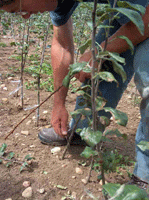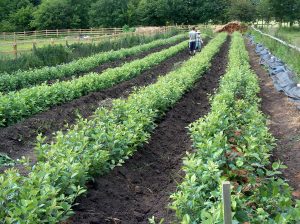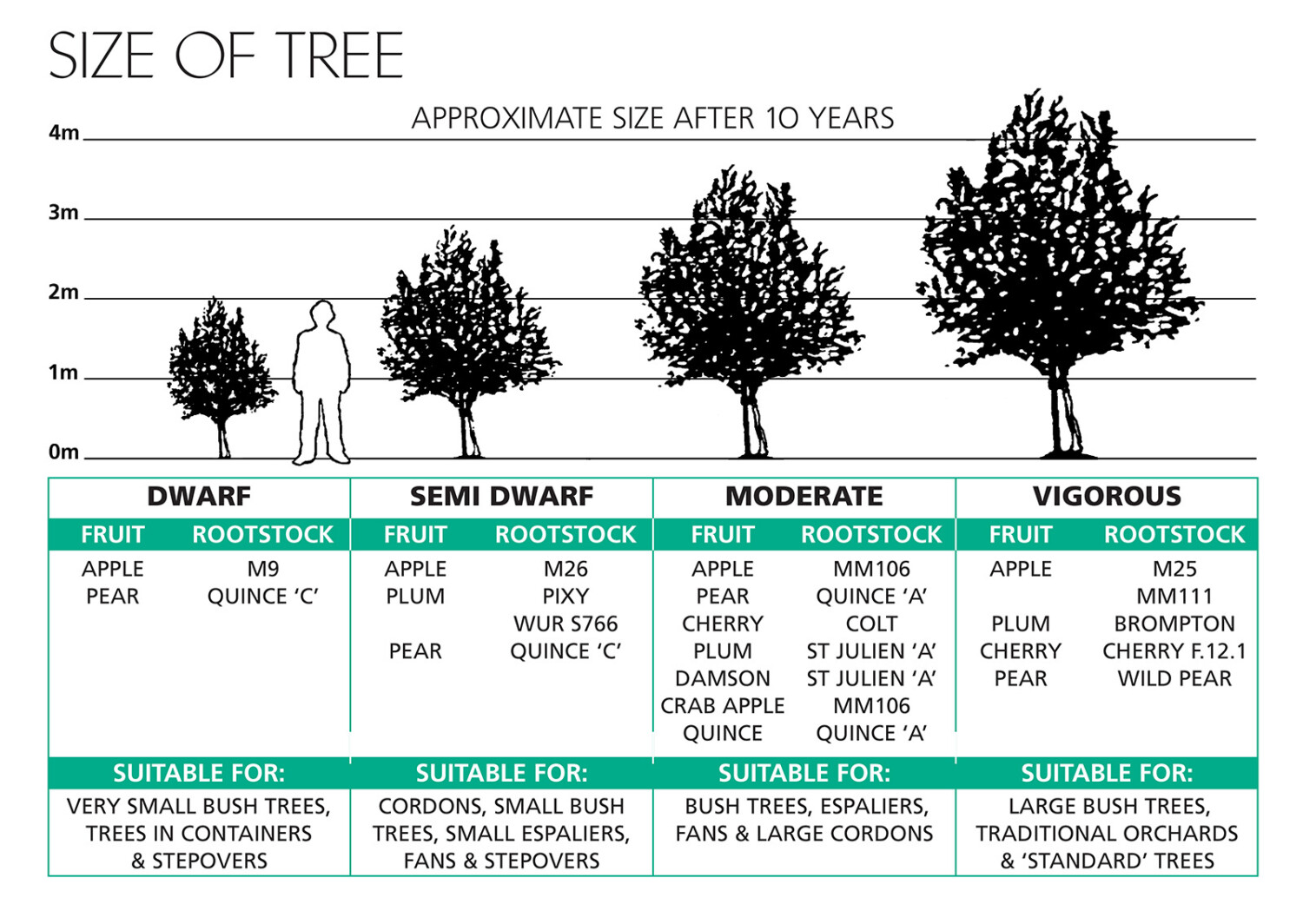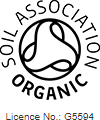 Fruit trees are grown on rootstocks with each type having different characteristics including:
Fruit trees are grown on rootstocks with each type having different characteristics including:
- Growth rate – determining eventual height and spread.
- Earliness into cropping. Dwarfer rootstocks come into cropping sooner.
- Resistance to pests ie Apple MM106 is resistant to woolly aphid.
- Advancing or delaying flowering and fruiting. Dwarfing rootstocks may advance both by up to a week, vigorous rootstocks may delay by up to a week.
As a general rule the more dwarfing the rootstock the more demanding it is of the soil as its roots will not grow as extensively. However it will come into fruiting earlier than its more vigorous counterpart.
The chart below gives the approximate sizes after 10 years:
We offer trees on the following rootstocks
Apples
MM106
Ideal for most situations and forms. Will reach 4-5m (12-15ft). Suitable for moderate sized gardens upwards as bush trees, longer cordons and espalers of four or more tiers. Quickly into fruiting, often in their second year after planting. Most of the apple varieties are available on this rootstock.
M26
Produces a semi dwarfing tree reaching 2.5-3.5m (8-12ft). Ideal for smaller gardens as bush trees, cordons and espaliers of up to two to three tiers. Soon into fruiting, often in second year after planting. Many apple varieties are available on this rootstock.
M9
Very dwarfing, producing trees of 1.8-3m (6-10ft). Suitable for small bush trees, step overs (single tier espaliers), small cordons. Early into bearing fruit, even in the first year ater fruiting – ideally remove the fruitlets before they develop. Requires good soil, permanent staking and no vegatation competition.
M25
Vigorous, potentially reaching 6m plus (20’+). Suitable for standard trees, traditional orchards and for grazing beneath. We offer trees as ‘maiden’ trees & some as two year ‘central leader’ trees where the central leader has been allowed to grow on. The two year trees are best collected from the nursery because of their height
See the catalogue for our full range of apple trees.
Plums & Damsons
St. Julien A
Moderate vigour, reaching 3.5-5.5m (12-18ft). All Plum and Damson varieties are available on this rootstock. Ideal for most situations resulting in trees with fruit at a pickable height.
Prunus spinosa WUR S766
A new semi dwarfing rootstock, up to two thirds the vigour of St. Julian A. We are moving towards growing a selection of plums on this rootstock in preference to Pixy. It has been intensively developed and extensively tested since the start of its breeding programme in the 1980s to its launch onto the commercial market in the 2010s. We are only able to offer two varieties of plum on this rootstock for winter 2021-22 but hope to have much more varieties available for following winters.
Brompton
Vigorous, reaching 6m plus (20’+). Suitable for standard trees, traditional orchards and for grazing beneath. a small amount of varieties available on this rootstock. These trees may well be taller than the length of the cartons we use for deliveries. Ideally collected from the nursery otherwise we may have to reduce in height.
See the catalogue for our full range of plum & damson trees.
Pears
Quince A
Moderate vigour resulting in a tree of 4-5m (12-15ft). Suitable for all forms – bush trees, cordons & espaliers. Into cropping within 4-6 years.
Quince C
Semi dwarf vigour resulting in a tree of 2.5-3.5m (8-12ft). Suitable for smaller bush trees, espaliers & cordons. Into cropping within 4-5 years.
Pyrus communis
Wild pear rootstock is used for the Perry Pears we supply. In time trees will become tall 6-15m (20-50′) depending on the variety. Can take a long time to come into cropping, often 10 or more years. No doubt where the saying ‘Pears for your heirs’ came from. In the past all pears would have been grown on this rootstock. Trees can be very long lived.
See the catalogue for our full range of Pears.
Quinces
Quince A
Moderate vigour resulting in a tree of 4-5m (12-15ft). Usually grown as bush trees but no reason why they cannot be grown as cordons or espaliers. Into cropping within 4-5 years.
See the catalogue for our range of quince trees.
Cherries
Gisela 5
A new dwarfing rootstock. Ideal for smaller gardens, for protection from birds and the weather without any loss in productivity.
See the catalogue for our full range of cherry trees.
Crab Apples
 All on MM106, moderate vigour rootstock to produce bush trees. Soon into cropping, often in the first year after planting.
All on MM106, moderate vigour rootstock to produce bush trees. Soon into cropping, often in the first year after planting.
See the catalogue for our full range of crab apple trees.
We do grow quite a few of our own apple rootstocks – we have established stoolbeds. We harvest them in January & February for planting the strongest, well rooted in the spring.
Further Information
- Pollination: Guidelines for successful pollination.
- Picking Times & Storage: Advice on picking & storage.



